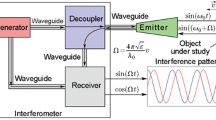Abstract
SOME years ago, Suits1 suggested and developed a method for the determination of the gas temperature of an arc discharge by the measurement of the velocity of a sound wave passing through the arc channel. The sound wave was obtained from the initiation of a spark discharge, and its propagation was observed by the increased brightness it produced in the channel. In his investigation, Suits observed that the original pressure disturbance created by the spark possessed abnormally high velocities which were rapidly attenuated with the propagation of the disturbance. However, since his experiments showed that for different spark-strengths, and hence for different abnormal velocities, the same velocity was always obtained when the disturbance had reached the arc, he assumed that the disturbance had become attenuated to one possessing the normal sound velocity.
Similar content being viewed by others
References
Suits, C. G., Physics, 6, 315 (1935).
Drabkina, S. I., J. Exp. Theor. Phys., 21, 473 (1951).
Author information
Authors and Affiliations
Rights and permissions
About this article
Cite this article
WHITTAKER, D., EDELS, H. Determination of Arc Temperatures using Shock Waves. Nature 177, 484–485 (1956). https://doi.org/10.1038/177484b0
Issue Date:
DOI: https://doi.org/10.1038/177484b0
- Springer Nature Limited





